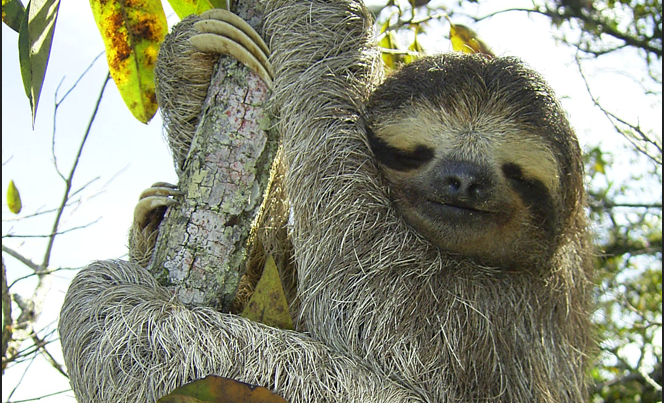Science News
Slothful Ecosystems
January 24, 2014
by Molly Michelson

Sloths are their own biodiverse ecosystems. These cute mammals, oft subjects of viral web videos, host habitats of their own, supporting moths, beetles, cockroaches, fungi and algae in their fur and on their skin. Some of these organisms are even endemic to the sloth—meaning they occur only on a sloth, and nowhere else!
This week, researchers describe how important sloth poop is to this slothy ecosystem, not to mention the sloth itself.
Three-toed sloths come down from their treetop perches once per week to poop. For years, people have been questioning this practice. Not the actual defecating, I mean—everyone poops, but rather the practice of leaving the safe and restful canopy.
Not only does this practice burn a good percentage of the sloth’s daily calories, but it’s also dangerous—the sloths are extremely vulnerable to predation on the forest floor. There must be a good reason to risk life and limb for the weekly trip.
The University of Wisconsin’s Jonathan Pauli has an idea. The moths that live aboard the sloths lay their eggs in the sloth poop, where their larvae hatch and grow, and eventually fly away to find a sloth home of their own.
Linking the moths to the sloths’ poop, Pauli checked the moth populations on several Costa Rican sloths. He also checked the sloths’ fur for nutrients. He found the more moths, the more nutrients, and the more nutrients, the more algae.
Pauli and his colleagues theorize that these algal nutrients supplement the sloths’ leaf-based diet, making the sloth, moth, algae relationship mutualistic, or beneficial to everyone involved.
And while Time reports that a quarter or so of the sloths had algae in their stomachs, no one quite understands how it got there. Sloths do not lick their fur, so if it is a beneficial relationship—how are sloths getting the nutritional benefits?
That means Pauli’s work is not yet finished… More slothful research!
The study is published in Proceedings of the Royal Society B.
(For more recent news on sloth ecosystems—check out this article and publication on how the fungi on sloths might protect humans from cancer, malaria and Chagas disease.)
Image: Stefan Laube (Tauchgurke)